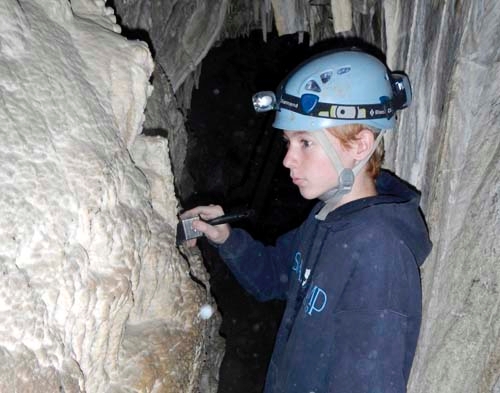Caves get cleaned up at Great Basin National Park
More than 30,000 people a year walk through the signature attraction at Great Basin National Park, and all of them leave something behind whether they mean to or not.
In the protected, windless environment of Lehman Caves, dirt, clothing fibers and hair carried in by tourists collects on the walls and the limestone formations.
After a while, features along the half-mile tour route start to look dingy and a little "fuzzy," said Gretchen Baker, ecologist for Nevada's only national park.
That can mean only one thing: It's time for lint camp.
Every so often, the park roughly 300 miles north of Las Vegas assembles a group of staff members and volunteers to clean the place from top to bottom.
They call it lint camp, Baker said, because that's what cave cleanups are called at other parks, including New Mexico's famed Carlsbad Caverns. Also, she said, "It's a way to make it sound more fun to go clean."
During Lehman's latest cleanup, held during Thanksgiving weekend, a crew of about 10 people worked more than 120 hours underground and hauled out nearly 40 pounds of dirt, lint and other debris from the most heavily trafficked parts of the cave.
"I was surprised by how much hair there is," Baker said with a laugh. "It's pretty disgusting, actually."
Most of it was cleaned from the walls a little bit at a time using standard, hardware-store paintbrushes, which Baker said carry a static charge perfect for picking up lint.
Cleaning wet formations required a bit more time and skill.
Debris was swept from the floor by someone with a Shop-Vac, taking care to avoid inadvertently collecting the bugs and other critters that call the cave home.
It was the first such cleanup at Lehman since 2009. Much of the work was done by members of a Las Vegas-based caving club known as the Southern Nevada Grotto. When they were finished, the tour route looked tidier and the cave formations brighter, Baker said.
But lint camp is not just an exercise in aesthetics. Baker said debris from visitors can stick to wet parts of the cave and change the way limestone formations grow. Foreign material also provides an unnatural food source for cave critters.
"We're trying to restore the cave to a more natural condition," Baker said.
Lehman Caves is the most popular stop at what is one of the least visited national parks outside of Alaska. The ornate series of caverns stretches for almost two miles, though most visitors see about half to three-quarters of it, depending on the length of the tour.
The temperature in the cave is a constant 50 degrees, and there are areas that can be wet or dry depending on the season.
A rancher named Absalom Lehman is widely credited with discovering the cave in the 1880s.
President Warren G. Harding declared Lehman Caves a national monument in 1922, but the site was left in the hands of private operators who allowed it to be used for underground gatherings, dances and weddings for almost a decade.
The monument was absorbed into Great Basin National Park when the 77,000-acre preserve was created in 1986.
Baker said she hopes to see lint camps become an annual event at Lehman Caves. Volunteers are now being sought for the next camp, set for Feb. 8 and 9.
Baker said participants will get a behind-the-scenes look at the cave that they can't get on the typical tour. They also will get to experience winter at the park, when crowds are never a problem and snowshoes and cross-country skis are a popular mode of transportation.
Baker said volunteers are free to help out for a few hours or stay for both days.
To sign up or get more information, send an email to Gretchen_Baker@nps.gov.
Contact reporter Henry Brean at hbrean@reviewjournal.com or 702-383-0350.

















